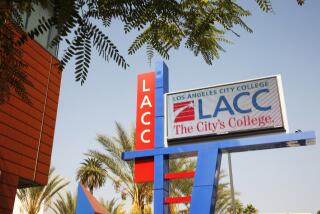College to Cut Staff, but Not Its Student Aid
- Share via
WHITTIER — Whittier College officials, while acknowledging that the school’s liberal financial aid policy contributed to a decade of money problems, last week vowed to continue helping needy students.
“Our commitment to financial aid will not change,” said Susan Pearce, vice president for college advancement, as college officials attempted to work out details of plans to bring the school’s spending into line with revenue.
“We have taken a very strong step forward academically,” said College President Eugene S. Mills, referring to the 101-year-old college’s growing academic reputation. “Financial aid was part of that commitment, and we will continue to have a strong commitment in that area.”
Officials of the 950-student college announced plans recently to eliminate nearly 10% of its teaching and administrative positions by the end of the school year. The college would have faced an operating deficit of at least $262,000 by the end of June if spending changes had not been made, officials said.
Budget Strained
Salaries at the private, Quaker-founded college, located in a quiet residential area west of the Uptown business district, make up much of the $20-million operating budget, college officials said.
They acknowledged, however, that financial aid programs strained the college’s finances, and were partly responsible for virtually depleting a $5-million reserve fund over an 11-year period.
Although tuition has tripled from $3,500 in 1978-79 to $10,500 today, Whittier College’s contribution to overall financial-aid funding in the same period has increased more than tenfold from $368,602 to $3.8 million, Finance Director Joseph E. Cardoza said.
That increase, as well as overly optimistic projections of student enrollment, caused the college to spend more money than it took in for nine of the past 11 years, Cardoza said.
Nearly 80% of students receive some sort of financial aid, a figure that is not unusual for colleges and universities. But Whittier College last year spent about 20% of its operating budget on financial aid, as much as 9 percentage points more than colleges of comparable size in the Southland.
Whittier’s comparatively low endowment contributed to the higher allocation of operating income to financial aid. The college has an endowment fund of $16 million, compared to a $250-million endowment fund at Pomona College and a $430-million endowment at Caltech, Cardoza said.
Most other colleges, with much larger endowments, set aside a smaller percentage of their operating budgets for financial aid, Cardoza said.
At Pomona College, for example, 12% of the college’s operating budget went to financial aid. Occidental College allocated 16% of its operating funds to aid students, and Harvey Mudd College devoted 11% of its operating budget to financial aid, according to those schools’ financial records.
In addition to the $3.8 million of college funds for financial aid, another $3.4 million in federal, state and restricted funds have been distributed this year by the college’s financial aid office, officials said.
“There has been a commitment here in general that nobody should be turned away for getting an education here because of financial difficulties,” sociology professor Les Howard said.
“We will continue to put together packages that make education possible” for students who cannot otherwise afford it, Howard said.
Change in Focus
Whittier College’s increase in financial aid coincided with the 1979 hiring of Mills and a plan by college staff to change the focus of the school’s liberal arts curriculum and seek a national reputation in academic excellence, college officials said. Mills will leave in June to complete a research project.
“We made the commitment to make a difference” in the academic programs, Dean of Students Robert B. Marks said. “We set out to achieve academic recognition, and we achieved that.”
As a result, Whittier College was ranked the fourth best small, comprehensive college in the nation by U.S. News & World Report in October. The weekly news magazine devotes an issue each year to judging the academic quality of 125 domestic colleges and universities. The year before, Whittier College was voted third in the same category.
The magazine cited Whittier College’s 7-year-old Liberal Education Program, which pairs unrelated classes to highlight possible similarities. For example, the college offers programs linking sociology with 19th-Century literature, Spanish with physical education and biology with ethics in religion.
Some students said they were drawn to Whittier College because of its small size, its growing academic reputation and financial aid packages that made the school more affordable than some state university systems.
“I could have stayed in Utah” and attended the state university system, said senior Holly Tuckett of Salt Lake City. She said she “practically got a free ride” through a Whittier College financial aid package based on need.
‘Real Good Package’
“They gave me a real good package,” said Tuckett, who works part time with severely handicapped children. “I figured, ‘What the heck, I can get a quality education from a private college . . . or go to a state school with 300 students in one class.’ ”
When she graduates in six months, she will begin paying back about $4,000 in federal and Whittier College loans accumulated over four years.
Other students agreed that Whittier College was the best option for them.
“I would have gone to City College,” said sophomore Michael Harris of Los Angeles. “If it wasn’t for Whittier, I wouldn’t be able to afford this education. It’s pretty decent here.”
Harris, a starting cornerback on the football team, said a financial aid package of $14,000 has covered virtually everything but $1,000 a year in dormitory fees.
Many Minorities
College officials said that recruiters have concentrated on bringing talented minority students to Whittier College. Almost 40% of Whittier College students are minority or foreign-born, according to financial aid office figures. About 90% of those who receive financial aid are minority students.
In 1985, a Times survey showed that Whittier College has a higher percentage of full-time undergraduate Latino students than any comparable small private college in Southern California. College officials said that they have remained committed to enrolling a high percentage of Latino students.
Miguel Santana, a sophomore from Bell Gardens, said that one of his Bell Gardens High teachers, a Whittier College alumnus, encouraged him to apply to the 4-year college rather than to a community college. The first of his family to continue his education after high school, Santana said that his family was not prepared to pay for any college.
After interviewing at Whittier, Santana said he became excited about the college. Now he wants to go on to graduate school and study political science. “I want to bring something back to my community,” Santana said. “I didn’t realize how important my background and my (Latino) community was until I came here.”
More to Read
Sign up for Essential California
The most important California stories and recommendations in your inbox every morning.
You may occasionally receive promotional content from the Los Angeles Times.













